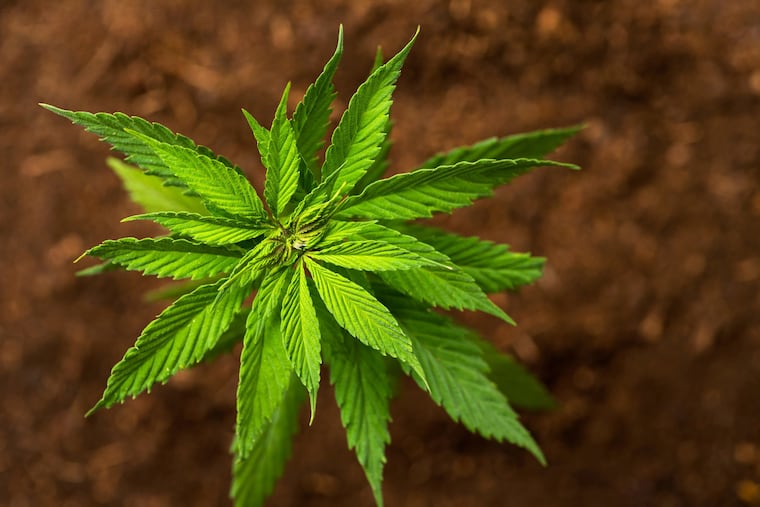Pennsylvania’s new hemp rules may hurt early farmers but boost the industry
Hemp could rocket to become one of Pa.’s major cash crops under new regulations. But those regulations could inadvertently crush small farmers who still are sitting on their 2019 hemp harvest.

Hemp could rocket to become one of Pennsylvania’s major cash crops under new regulations published last week by the state Department of Agriculture. At the same time, those new regulations could inadvertently crush small farmers who still are sitting on their 2019 hemp harvest.
Pioneering hemp farmers, who grew the crop under the state’s experimental pilot program, may find that their cannabis plants — now stored in barns and warehouses — may be too laden with the intoxicating substance THC to be approved for sale, legal experts said. Several thousands of acres of hemp were planted in Pennsylvania last year.
Under the state’s new standards and requirements, testing will be increased significantly for marijuana’s non-intoxicating cousin.
The act, which is effective immediately, “represents a fundamental change in how the hemp industry is regulated in Pennsylvania,” said Bill Roark, an attorney who is cochair of the Pennsylvania Bar Association’s Medical Marijuana and Hemp Law Committee.
According to the Department of Agriculture, hemp can be processed into thousands of products — including food, textiles, construction materials, oils, and the fashionable dietary supplement CBD. Analysts project that by 2025, hemp could become a $25 billion industry.
Farmers are looking at hemp as a lucrative crop. Where an acre of corn might generate $300 to $500 in profit, and tobacco $1,000 to $3,000, they expect some hemp varieties — those grown for CBD extraction — to fetch $10,000 or more.
Applications to grow hemp and instructions were posted last week on the state Department of Agriculture’s website.
By definition industrial hemp may contain only 0.3 percent THC, the intoxicating compound in marijuana. Smokable medical marijuana flower — when it’s available — typically contains between 7% and 35% THC.
The U.S. Department of Agriculture has said it will allow hemp producers some leeway, but not much. Any hemp containing over 0.5 percent THC must be destroyed.
Here’s where potential problems exist for last year’s hemp farmers.
Hemp grown in Pennsylvania last year was tested only for delta-9 THC, usually the most prevalent psychoactive cannabinoid in the plant. But in 2020, testing also will include THCA, a precursor compound that is converted to THC with the application of heat.
“A lot of growers produced plants where the delta-9 THC level was below 0.3, but the THCA level was well in excess, sometimes 1, 2, or 3 percent," said Roark.
And that might explain why so many people who smoked hemp flower this past year reported getting high from it.
“They fixed that loophole, now I’m afraid that will render a lot of plants grown last year unusable,” Roark said. “There are barns and warehouses full of it. Some farmers have spent thousands of dollars growing it. By law, processors will have to reject the hemp because it will test ‘hot,’ that is, way above the acceptable 2020 levels.”
The vice president of Hoophouse, a Bucks County-based hemp grower and processor, said his company already has had to turn down a contract to process 80,000 pounds of hemp from an out-of-state producer. “It was over the THC limit so we had to refuse it,” said Matt Baxter. “So we’re aware that some farmers are having issues.”
Other than the new THC guidelines, most of the new regulations were greeted enthusiastically by Pennsylvania hemp experts.
“It’s definitely a step in the right direction,” said Erica Stark, the executive director of the Pennsylvania Hemp Industry Council. “The Pennsylvania program is as flexible as it can be while remaining compliant with federal law.”
Individual farmers may plant as many acres as they desire. But backyard hemp gardens are effectively forbidden — no hemp may be grown within 200 feet of a residential dwelling. Outdoor farmers must cultivate a minimum of 300 plants on at least a quarter acre. Indoor growers must maintain a minimum of 2,000 square feet and 200 plants. The price of a hemp permit — which was once $3,000 two years ago — has plummeted to $150.
Those provisions and permit price breaks may encourage more agricultural pros to consider hemp.
But Stark worries about the necessary infrastructure needed to ensure hemp crops find a market. Among the new regulations are requirements for THC testing at several stops along the supply chain. There may not be enough testing labs in the state to prevent serious bottlenecks. “There are only so many labs across the entire country,” she said. “I’m concerned about the logistics.”
There are also few processors capable of rendering hemp into sellable materials in the state. The new standards allow for stand-alone processor permits.
Among other notable standards in the new regulations:
Hemp may not be grown within three miles of any medical marijuana facility, which is likely intended to prevent cross pollination, and it must not be cultivated within 1,000 feet of any school pre-K through 12.
Anyone with a financial interest in producing or processing hemp must undergo an FBI background check.
Stark’s husband, Les Stark, is also a hemp activist, grower, and moderator of the Keystone Cannabis Coalition Facebook group. Though he’s optimistic about the future, he’s advising aspiring farmers to be cautious.
“I’ve been trying to build enthusiasm for 20 years,” Les Stark said. “Now I’m trying to tamp it down a little bit. I don’t want people to have 100 acres of hemp and not have a market. You don’t want to put seeds in the ground until you have a contract to sell it.
“I know farmers who were successful, but also know farmers who took a gamble but couldn’t find a buyer,” he said.